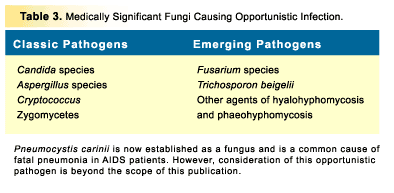In the health-care setting, the key organisms causing nosocomial fungal disease are the opportunistic pathogens Candida species and Aspergillus species. However, the emergence of other fungal species not previously associated with pathology, e.g., Fusarium, Trichosporon, Alternaria, is a clear cause for concern (Table 3) [9].

Infection due to Candida species in critically ill patients usually arises from the patient’s endogenous flora and highlights the importance of an intact host-defense system in resisting invasive fungal infection. Approximately 80% of normal healthy individuals carry one or more of the Candida species as part of the normal flora of the gastrointestinal or genitourinary tract. However, these commensal organisms can become pathogenic if Competing bacterial flora are suppressed by antibiotics or if mussel damage and Neutropenic are present.
The incidence of aspergillosis has been increasing. In one US hospital, only 30 cases were reported in a 12-year period between 1951 and 1963, and this rose to 91 cases in a 5-year period between 1971 and 1976 [10]. Aspergillus species are ubiquitous in soil, water, and decaying vegetation. In the hospital environment, conidia can be isolated from the air, ventilation systems, and dust. Most infections are acquired via airborne transmission. Colonization of the respiratory tract is followed by invasive infection if host defenses are compromised. Data from the NNIS indicate that only 1.1% of hospitalwide fungal infections reported between 1980 and 1990 were caused by Aspergillus [6]; however, in specialized units the incidence is often much higher. The crude mortality is high, with estimates up to 95% in some patient populations.
Course Number: V035B.043001
This CME Expires on July 1, 2003; no tests will be accepted after this date.
This course is accredited by
The University of Pittsburgh School of Medicine, Center for Continuing Education
|

